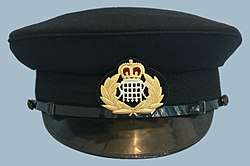Waterguard
The Waterguard was a division of HM Customs and Excise (HMCE) responsible for the control of vessels, aircraft, vehicles and persons arriving into and departing from the United Kingdom. This included crew members and passengers, as well as persons travelling on foot. Waterguard officers were responsible for applying the allowances provided for in law and for collection of customs and excise revenue on the excess. The officers were also responsible for the enforcement of the prohibitions and restrictions, including controlled drugs and plant and animal health. With the reorganization of HM Customs and Excise in 1972 the Waterguard was renamed the 'Preventive Service' and the functions of the Waterguard continued to be carried out as part of the HMCE (and its successor HM Revenue and Customs) until the establishment of the UK Border Agency in 2008.

History
Formed in 1809 as the "Preventive Waterguard" (also known as the Preventive Boat Service[1]) to combat smuggling, the Waterguard was an independent arm of revenue enforcement and complemented the "riding officers" (stationed along the south coast of England) who patrolled the shore on horseback, and the offshore revenue cutters (which were owned and operated by both the Board of Customs and the Board of Excise). The Waterguard was initially based in Watch Houses around the coast, and boat crews patrolled inshore waters around the coast in small boats each night. It was placed under Admiralty control from 1816 to 1822, when it and the riding officers and cutters were amalgamated under the control of HM Customs and renamed the Coast Guard (itself placed under Admiralty control in 1856). With the Coast Guard having moved away from preventive work in the years that followed, the Waterguard was re-formed as part of HM Customs in 1891 and absorbed into the Customs and Excise department in 1909.
Description
Members of the Waterguard were uniformed officers whose uniform was very similar to that of a Royal Navy officer. From 1949, there were only 3 differences between the uniform worn by a Waterguard officer and that worn by a Royal Navy officer:
- The Cap Badge showed the Departmental Portcullis Logo whereas a Royal Navy officer's Cap Badge showed the traditional Fouled Anchor.
- The Uniform Buttons showed the Crown whereas a Royal Navy officer's Uniform Buttons showed the traditional Fouled Anchor.
- The Marks of Rank (Sleeve Lace) extended halfway around the sleeve whereas a Royal Navy officer's Marks of Rank will extend completely around the sleeve.
The name "Waterguard" became misleading after 1923, when their domain was extended to the border between Northern Ireland and the Irish Free State (now the Republic of Ireland), and they also came to carry out controls at airports and other places of entry into the United Kingdom. Waterguard officers were often referred to simply as "customs officers", although until 1972 Officers of Customs and Excise were non-uniformed, the outdoor service, and were responsible for the examination and clearance of cargo (rather than passengers), as well as control of Purchase Tax. When Purchase Tax was replaced by VAT, control of this tax became the responsibility of HM Customs and Excise.
Prior to 1972, the basic grade in the Waterguard was that of Assistant Preventive Officer, and advancement could be made through the ranks to the grades of Preventive Officer then Chief Preventive Officer, initially by way of written examination then interview. Further advancement was possible within the Waterguard structure, up to the highest grade of Inspector General of Waterguard.
See also
- HM Coastguard
- HM Customs and Excise
References
- House of Commons Sessional Papers 1819 (569) XVII, 77; "A Return of Officers and Men appointed to the Preventive Boat Service between November 1816 and March 1819"